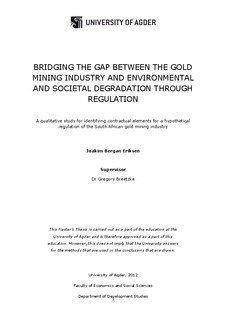| dc.description.abstract | This paper provides an identification and analysis of the contractual elements, i.e. requirements, for a hypothetical regulation of the South African gold mining industry. The identification of contractual elements is based on their probability in contributing in reversing trends of environmental and societal degradation deriving from gold mining. Second, this thesis explores the potential for such a regulation to achieve these objectives in South Africa.
Except from a few initiatives of variable qualities, the gold mining industry at large is unregulated, and it is as such very much similar to the diamond industry prior to 2003. In clear contrast to other segments of the extractive industry sector such as the relatively similar diamond industry, a holistic juridical framework for the gold mining industry does not exist. The outcome is a gold mining industry where environmental and societal degradation frequently occurs, and where internationally accepted human rights laws are being repeatedly violated. Despite a set of World Bank-, United Nations- and NGO-reports, awareness concerning the issue is low. The study has found that regulation of the gold mining industry is feasible, and that such a regulation is likely to contribute in reversing the unsustainable trend of degradation.
Furthermore, the research conclude that the regulatory body of the regulation should consist of the UN, the World Bank, the World Gold Council, the gold mining industry, respective governments and NGOs such as Save the Children and the WWF so that the wide range of its stakeholders are represented. A set of ten contractual elements, i.e. requirements, have been identified based on findings from the interviews, the analysis of existing alternative regulatory agreements and two participant observations. The contractual elements and the regulatory body have been summarised in a document named The Clean Gold Regulation; a document acting as a summary of the study’s findings presented at the end of the analyses in chapter five.
Finally, the Clean Gold Regulation has been evaluated regarding its feasibility in South Africa. Whereas civil society’s support of the proposed regulation is high, the latent support and awareness from the political South African environment is weak. Political instability may question the creation and feasibility of such an agreement in South Africa, and local barriers such as poor border control, smuggling and the existence of the black market may jeopardise the potential for a feasible South African regulation. | no_NO |
